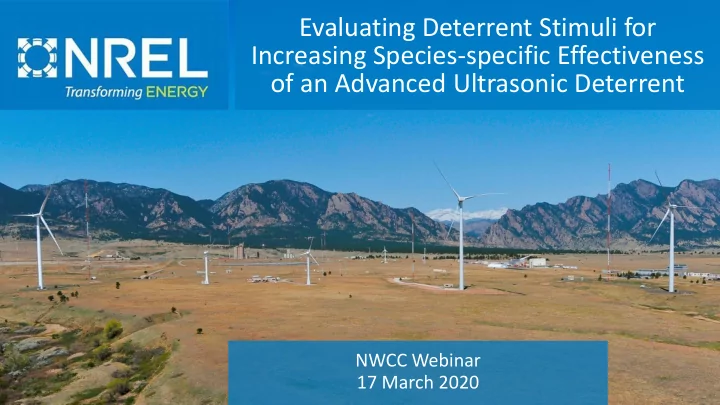

Evaluating Deterrent Stimuli for Increasing Species-specific Effectiveness of an Advanced Ultrasonic Deterrent NWCC Webinar 17 March 2020
Project Team Wildlife Imaging Systems NREL | 2
Project Goal Hoary bat (Photo by Cris Hein) • Understand how bats are responding to ultrasonic acoustic deterrents (UADs) & improve the effectiveness of UADs for as many species as possible Silver-haired bat (Photo by Cris Hein) NREL | 3
Project Objectives • Quantify the relationship between bats & sound pressure level (SPL) at different frequencies – ‘Low’ frequency (20– 32 kHz) – ‘High’ frequency (38– 50 kHz) – ‘All’ frequency (20– 50 kHz) NRG System’s deterrent (Photo by Brittany Stamp) • Observe potential seasonal differences in behaviors (i.e., spring vs. autumn) • Determine whether bats change their echolocation characteristics in the presence of deterrent signals NREL | 4
Methodology • ‘Open air’ flight cage – 60 m x 9.8 m x 4.3 m Project team assembling the flight cage at Texas State University (Video by Rob Tyler) NREL | 5
Methodology • Use thermal video cameras & acoustic detectors to record flight & echolocation behavior between control & treatment conditions • Randomize treatments • Randomize deterrent signal location Session Time (minutes) Control 4 Treatment 1 4 Control 4 Treatment 2 4 Control 4 Treatment 3 4 Control 4 NREL | 6
Preliminary Trials • Initiated autumn 2019 • Conducted trials – 30 cave myotis ( Myotis velifer ) – 12 Brazilian free-tailed bats ( Tadarida brasiliensis ) • Fine-tuning tracking software to output quantitative data • Spring 2020 – Tricolored, eastern red & evening bats Bat flight track (Image by Brittany Stamp) NREL | 7
Anticipated Outcomes • Response among treatments – Do ‘high - frequency’ bats respond to ‘low - frequency’ deterrent signals? • Shifts in echolocation – Do bats shift the frequency of their calls to get ‘outside’ the deterrent signal? • Importance: May allow UADs to focus on Fringed Myotis (Photo by Cris Hein) ‘low - frequency’ signals NREL | 8
Anticipated Outcomes • Relationship between SPL & distance – Importance: Provides a SPL to target that will deter bats the length of the blade • Response between spring & autumn – Importance: Studies conducted in spring may not be applicable OR we can pool data across seasons Graduate students reviewing thermal video (Photo by Sarah Fritts) • Big Caveat: study conducted in a flight cage without the potential attraction of a wind turbine NREL | 9
Next Steps • 2020: Spring season suspended. Resume testing in autumn • 2021: Report results • 2021+: Continue using the flight cage to investigate additional treatments that further enhance the effectiveness of deterrents Western red bat (Photo by Cris Hein) NREL | 10
Acknowledgements • This material is based upon work supported by the U.S. Department of Energy’s Office of Energy Efficiency and Renewable Energy (EERE) under the Wind Energy Technology Office Award #DE-FOA-0001924-1535 • https://www.energy.gov/eere/wind/environmental-impacts-and- siting-wind-projects • Disclaimer: “This report was prepared as an account of work sponsored by an agency of the United States Government. Neither the United States Government nor any agency thereof, nor any of their employees, makes any warranty, express or implied, or assumes any legal liability or responsibility for the accuracy, completeness, or usefulness of any information, apparatus, product, or process disclosed, or represents that its use would not infringe privately owned rights. Reference herein to any specific commercial product, process, or service by trade name, trademark, manufacturer, or otherwise does not necessarily constitute or imply its endorsement, recommendation, or favoring by the United States Government or any agency thereof. The views and opinions of authors expressed herein do not necessarily state or reflect those of the United States Government or any agency thereof.” NREL | 11
Thank you www.nrel.gov Brazilian free-tailed bats (Photo by Cris Hein) This work was authored by the National Renewable Energy Laboratory, operated by Alliance for Sustainable Energy, LLC, for the U.S. Department of Energy (DOE) under Contract No. DE-AC36-08GO28308. Funding provided by U.S. Department of Energy Office of Energy Efficiency and Renewable Energy. The views expressed in the article do not necessarily represent the views of the DOE or the U.S. Government. The U.S. Government retains and the publisher, by accepting the article for publication, acknowledges that the U.S. Government retains a nonexclusive, paid-up, irrevocable, worldwide license to publish or reproduce the published form of this work, or allow others to do so, for U.S. Government purposes.
Recommend
More recommend